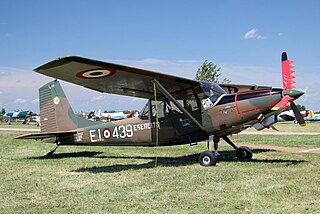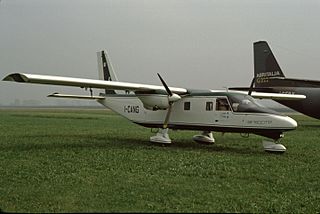
The British Aerospace Jetstream 41 is a turboprop-powered feederliner and regional airliner, designed by British Aerospace as a stretched version of the popular Jetstream 31. Intended to compete directly with 30-seat aircraft like the Embraer Brasilia, Dornier 328 and Saab 340, the new design eventually accommodated 29 passengers in a two-by-one arrangement like the Jetstream 31. Eastern Airways of the UK is the biggest operator of Jetstream 41s in the world, with 14 in the fleet.

The Aermacchi AM.3 was the result of a joint venture between Aermacchi and Aeritalia in response to an Italian Army requirement for an aircraft to replace the Cessna L-19, and was initially designated the MB-335.

The Valmet L-90 Redigo is a turboprop-powered military basic trainer aircraft and liaison aircraft, a development of Valmet's earlier training aircraft for the Finnish Air Force. The L-90 was the last military aircraft designed and produced in Finland.

The Valmet L-70 Vinka is a Finnish-designed piston-powered military basic trainer aircraft of the 1970s. A production run of 30 aircraft were built for the Finnish Air Force in the early 1980s, and although the type was not exported, it formed the basis of the turboprop-powered Aermacchi M-290 RediGO.
The IAR-825 Triumf is a Romanian-designed tandem multirole trainer aircraft based on the IAR-823 built for the Romanian Air Force. The aircraft is roughly in the same class with the Brazilian EMBRAER Tucano. The IAR-825 is equipped with the Canadian Pratt & Whitney Canada PT6 turboprop engine. The type's first flight took place on the 12 June 1982.

The Cessna 425, known as the Corsair and later as the Conquest I, is an eight-seat American pressurized turboprop twin-engined light aircraft. Now out of production, it was built by Cessna Aircraft of Wichita, Kansas, between 1980 and 1986.

The Harbin Y-11 is a high wing twin-engine piston utility and geological survey aircraft built by Harbin Aircraft Manufacturing Corporation (HAMC).

The Valmet PIK-23 Towmaster or Suhinu is a Finnish two-seater glider-towing/primary trainer aircraft built entirely out of composite materials in the early 1980s.

The Ahrens AR 404 was a prototype American civil transport aircraft first flown in 1976, a high-wing monoplane powered by four turboprop engines. In order to facilitate the loading and unloading of cargo, the fuselage was of constant rectangular section along almost its entire length, the main undercarriage was retracted into sponsons on the fuselage sides, and the tail included a loading ramp. As a regional airliner, the AR 404 was designed to carry 30 passengers, or in its cargo configuration, to accommodate four standard D3 freight containers.

The AIDC T-CH-1 Chung Hsing was a turboprop-powered military trainer aircraft produced in Taiwan.

The AIDC XC-2 was a prototype civil transport aircraft designed in the 1970s in Taiwan. It was a high-wing monoplane powered by two turboprop engines. The main undercarriage was carried in sponsons on either side of the boxy fuselage, maximising internal space.

The Air Tractor AT-300 is a family of agricultural aircraft that first flew in the United States on September 1973. Type certification was awarded to Air Tractor in November the same year, and serial production commenced in 1976. Of low-wing monoplane taildragger configuration, they carry a chemical hopper between the engine firewall and the cockpit.

ENAER T-35 Pillán is a Chilean propeller-driven basic trainer aircraft. The student and the instructor sit in tandem. Production ceased in 1991 after 7 years but restarted briefly in 1998.

The Fuji T-5 or KM-2Kai is a Japanese turboprop-driven primary trainer aircraft, which is a development of the earlier Fuji KM-2. The student and the instructor sit side-by-side.

The Kawasaki P-2J is a maritime patrol and ASW aircraft developed for the Japan Maritime Self-Defense Force. A turboprop-powered version of the radial-engined P-2 Neptune, the P-2J was developed as an alternative to buying the larger and more expensive P-3 Orion, which would eventually replace the P-2J in the 1980s.

The SIAI-Marchetti SM.1019 is an Italian STOL liaison monoplane built by SIAI-Marchetti for the Italian Army. It is a turboprop-powered derivative of the Cessna O-1 Bird Dog.

The Vulcanair SF.600 Canguro was a feederliner developed in Italy in the late 1970s. Despite a number of attempts to put the aircraft into series production, only a small number were ever built. The Canguro was a high-wing cantilever monoplane of conventional configuration with a fuselage of rectangular cross-section and a high-set tail. The tricycle undercarriage was not retractable, and its main units were carried on sponsons on the fuselage sides. SIAI Marchetti provided funding towards the construction of the prototype, and constructed this aircraft at the former Aviamilano plant. After flight testing proved positive, the type was put on sale, but failed to attract buyers in any number, even when the original piston engines were exchanged for turboprops and retractable undercarriage was offered as an option.

The Italair F.20 Pegaso was a twin-engine utility aircraft designed by Stelio Frati and built in Italy in 1971.

The IAR-827 was an agricultural aircraft built in Romania in the 1970s and 1980s. The penultimate member of the family of designs that began with the IAR-821, it was, like the others, a conventional low-wing monoplane with fixed, tailwheel undercarriage, and shared the all-metal construction of the IAR-826. The prototype flew in 1976, powered by a Lycoming IO-720 engine, but the production examples that followed all had the PZL-3S.

The Fuji T-7 is a Japanese primary trainer aircraft built by Fuji Heavy Industries for the Japan Air Self-Defense Force. A development of Fuji's earlier T-3 trainer, it is a single-engined monoplane powered by a turboprop engine.


















